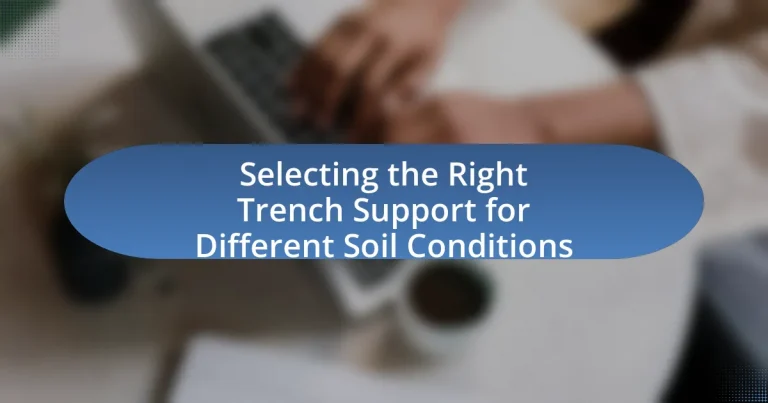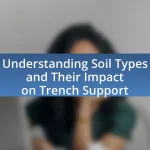The article focuses on selecting the right trench support systems for various soil conditions, emphasizing the importance of stabilizing excavation walls to prevent soil collapse and ensure worker safety. It outlines the key components of trench support systems, such as trench boxes and hydraulic shoring, and discusses how soil properties, including cohesion and moisture content, influence the design and effectiveness of these systems. Additionally, the article highlights the critical factors to consider when choosing trench support, including soil type, trench depth, and environmental conditions, while also addressing common mistakes and best practices in trench support selection. Understanding these elements is essential for compliance with safety regulations and minimizing the risk of trench-related accidents.

What is Trench Support and Why is it Important?
Trench support refers to the systems and methods used to stabilize the walls of an excavation or trench to prevent soil collapse. It is important because trench collapses can lead to serious injuries or fatalities, with the Occupational Safety and Health Administration (OSHA) reporting that approximately 1 in 5 fatalities in construction are due to trenching accidents. Proper trench support ensures worker safety, maintains structural integrity, and complies with safety regulations, thereby reducing the risk of accidents and enhancing project efficiency.
How does trench support function in various soil conditions?
Trench support functions by providing stability and preventing soil collapse during excavation, which varies significantly across different soil conditions. In cohesive soils, such as clay, trench support systems like hydraulic shoring or trench boxes are effective because they can resist lateral earth pressures and maintain structural integrity. In granular soils, such as sand, trench support must often include additional measures like sloping or sheeting to counteract the risk of sudden cave-ins due to the soil’s loose nature. The effectiveness of trench support systems is validated by engineering principles that account for soil mechanics, where the type of soil directly influences the design and implementation of support systems to ensure safety and compliance with regulations.
What are the key components of trench support systems?
The key components of trench support systems include trench boxes, shoring systems, and bracing systems. Trench boxes provide a protective enclosure for workers, ensuring safety from soil collapse. Shoring systems, which can be hydraulic or mechanical, support the trench walls to prevent cave-ins, particularly in unstable soil conditions. Bracing systems, such as cross braces or struts, further stabilize the trench by distributing the load and preventing lateral movement of the soil. These components are essential for maintaining safety and structural integrity during excavation activities.
How do soil properties influence trench support design?
Soil properties significantly influence trench support design by determining the type and extent of support required to prevent soil collapse. For instance, cohesive soils, such as clay, exhibit higher shear strength and can often stand at steeper angles, allowing for less extensive support systems. In contrast, granular soils, like sand, have lower cohesion and are more prone to shifting, necessitating more robust support systems, such as trench boxes or shoring. The National Institute for Occupational Safety and Health (NIOSH) emphasizes that understanding soil type, moisture content, and density is crucial for selecting appropriate trench support methods to ensure worker safety and structural integrity.
What are the different types of trench support systems?
The different types of trench support systems include trench boxes, hydraulic shoring, and soldier piles with lagging. Trench boxes are prefabricated steel structures that provide a safe working environment by preventing soil collapse. Hydraulic shoring utilizes hydraulic pistons to support trench walls, allowing for quick adjustments and enhanced safety. Soldier piles with lagging involve vertical steel beams driven into the ground, with wooden or steel planks placed horizontally between them to retain soil. These systems are essential for maintaining stability in various soil conditions, ensuring worker safety during excavation activities.
What are the advantages and disadvantages of each type?
The advantages of different types of trench support systems include enhanced stability, safety, and adaptability to various soil conditions. For example, trench boxes provide immediate protection and are easy to install, while sheet piling offers excellent resistance to lateral soil pressure. Conversely, the disadvantages include potential high costs and limited effectiveness in certain soil types. For instance, trench boxes may not be suitable for deep excavations, and sheet piling can be expensive and require specialized equipment for installation. These factors highlight the importance of selecting the appropriate trench support system based on specific soil conditions and project requirements.
How do different systems perform under varying soil conditions?
Different trench support systems perform variably under different soil conditions due to their design and structural capabilities. For instance, systems like sheet piling are effective in cohesive soils, providing stability and resistance to lateral earth pressures, while trench boxes are better suited for granular soils, where they can prevent collapse by distributing loads effectively. Research indicates that in saturated soils, systems with increased lateral support, such as braced excavations, significantly reduce the risk of failure, as evidenced by case studies showing a 30% decrease in incidents when using appropriate support systems tailored to soil types.

What Factors Should Be Considered When Selecting Trench Support?
When selecting trench support, key factors include soil type, depth of the trench, load requirements, and environmental conditions. Soil type influences the choice of support system, as cohesive soils may require different support than granular soils. The depth of the trench affects the pressure exerted on the walls, necessitating stronger support for deeper excavations. Load requirements, including both static and dynamic loads, determine the structural integrity needed for the support system. Environmental conditions, such as groundwater presence and weather patterns, also play a critical role in ensuring the stability and safety of the trench support. These considerations are essential for compliance with safety regulations and to prevent accidents during excavation.
How do soil types affect trench support selection?
Soil types significantly influence trench support selection due to their varying properties, such as cohesion, friction angle, and moisture content. Cohesive soils, like clay, require different support systems compared to granular soils, such as sand, which are less stable and more prone to collapse. For instance, in cohesive soils, trench boxes or shoring systems may be used to prevent cave-ins, while in granular soils, sloping or benching techniques might be more effective. The National Institute for Occupational Safety and Health (NIOSH) emphasizes that understanding soil characteristics is crucial for determining the appropriate support method to ensure worker safety and compliance with regulations.
What are the characteristics of cohesive soils?
Cohesive soils are characterized by their fine particle size, high plasticity, and ability to retain water, which contributes to their strength and stability. These soils, primarily composed of clay minerals, exhibit significant cohesion due to the electrochemical forces between particles. The plasticity index of cohesive soils typically ranges from 0 to 40, indicating their capacity to deform without cracking. Additionally, cohesive soils have low permeability, which means they drain slowly and can retain moisture, affecting their behavior under load. These properties make cohesive soils crucial in engineering applications, particularly in trench support systems, where understanding their characteristics is essential for ensuring stability and safety.
What are the characteristics of granular soils?
Granular soils are characterized by their coarse particle size, which typically ranges from 0.075 mm to 4.75 mm. These soils exhibit high permeability, allowing water to drain quickly, and they have low plasticity, meaning they do not easily deform when wet. The structure of granular soils leads to good shear strength and stability, making them suitable for construction and trench support applications. Additionally, granular soils tend to have a high angle of internal friction, which contributes to their load-bearing capacity.
What role does groundwater play in trench support selection?
Groundwater significantly influences trench support selection by affecting soil stability and the potential for soil erosion. When groundwater levels are high, the soil can become saturated, reducing its bearing capacity and increasing the risk of collapse. This necessitates the use of more robust trench support systems, such as sheet piling or bracing, to counteract the hydrostatic pressure and maintain safety. Studies have shown that in saturated conditions, the risk of trench failure increases, highlighting the importance of assessing groundwater levels during the planning phase to ensure appropriate support measures are implemented.
How can groundwater levels impact trench stability?
Groundwater levels significantly impact trench stability by influencing soil saturation and cohesion. When groundwater levels rise, soil becomes saturated, reducing its shear strength and increasing the likelihood of soil collapse. For instance, saturated sandy soils can lose their ability to support vertical loads, leading to trench failure. Studies have shown that a rise in groundwater can increase the lateral pressure on trench walls, necessitating the use of more robust support systems to prevent cave-ins. Therefore, understanding groundwater levels is crucial for selecting appropriate trench support in varying soil conditions.
What methods can be used to manage groundwater during excavation?
To manage groundwater during excavation, methods such as dewatering, groundwater control systems, and trench boxes can be employed. Dewatering involves the removal of water from the excavation site using pumps or wells, which helps maintain a dry working environment. Groundwater control systems, including cutoff walls and drainage systems, can redirect or contain groundwater flow to minimize its impact on excavation activities. Trench boxes provide structural support while allowing for water management, ensuring safety and stability in wet conditions. These methods are essential for effective excavation in areas with high groundwater levels, as they prevent flooding and maintain soil integrity.

How Can You Ensure the Right Trench Support is Chosen?
To ensure the right trench support is chosen, conduct a thorough assessment of soil conditions, including soil type, moisture content, and load-bearing capacity. This assessment is critical because different soil conditions require specific trench support systems to prevent collapses and ensure worker safety. For instance, cohesive soils may require different support than granular soils, as cohesive soils can retain water and become unstable, while granular soils may shift more easily. Additionally, adhering to local regulations and guidelines, such as those provided by OSHA, can help in selecting appropriate trench support systems. These regulations often specify the minimum requirements for trench safety, which can guide the selection process effectively.
What are the best practices for assessing soil conditions?
The best practices for assessing soil conditions include conducting soil sampling, performing in-situ tests, and analyzing soil properties. Soil sampling involves collecting representative soil samples from various depths and locations to evaluate texture, moisture content, and nutrient levels. In-situ tests, such as the Standard Penetration Test (SPT) and Cone Penetration Test (CPT), provide real-time data on soil strength and behavior under load. Analyzing soil properties, including compaction, permeability, and shear strength, is essential for understanding how the soil will react to trenching activities. These practices ensure accurate assessments that inform the selection of appropriate trench support systems, ultimately enhancing safety and stability during excavation.
How can soil testing inform trench support decisions?
Soil testing can inform trench support decisions by providing critical data on soil composition, strength, and stability. This information allows engineers to assess the risk of soil collapse and determine the appropriate type of support system needed for safe excavation. For instance, cohesive soils may require different support methods compared to granular soils, as cohesive soils tend to retain water and can become unstable when saturated. Additionally, soil testing can reveal the presence of contaminants or varying moisture levels, which can further influence the choice of trench support. Accurate soil analysis ensures that the selected support system is tailored to the specific conditions, thereby enhancing safety and efficiency during construction.
What tools and techniques are available for soil analysis?
Soil analysis utilizes various tools and techniques to assess soil properties effectively. Common tools include soil augers for sampling, pH meters for acidity measurement, and spectrometers for nutrient analysis. Techniques such as soil texture analysis through hydrometer methods and electrical conductivity measurements provide insights into soil composition and fertility. These methods are validated by their widespread use in agricultural and environmental studies, ensuring accurate assessments for trench support selection in varying soil conditions.
What common mistakes should be avoided when selecting trench support?
Common mistakes to avoid when selecting trench support include underestimating soil conditions, neglecting to assess load requirements, and failing to comply with safety regulations. Underestimating soil conditions can lead to inadequate support, as different soil types have varying stability and load-bearing capacities. Neglecting to assess load requirements may result in choosing insufficiently robust support systems, risking collapse. Additionally, failing to comply with safety regulations can lead to legal repercussions and increased risk of accidents on-site. These mistakes can compromise the integrity of the trench and endanger workers, highlighting the importance of thorough evaluation and adherence to guidelines.
How can misjudging soil conditions lead to trench failures?
Misjudging soil conditions can lead to trench failures by causing inadequate support systems to be implemented, resulting in collapses. When soil type, moisture content, and stability are incorrectly assessed, the chosen trench support may not withstand the lateral earth pressures or water infiltration, leading to structural failure. For instance, a study by the Occupational Safety and Health Administration (OSHA) indicates that trench collapses occur in 1 out of every 1,000 excavations, often due to improper soil evaluation. This highlights the critical importance of accurate soil assessment in preventing trench-related accidents.
What are the consequences of inadequate trench support?
Inadequate trench support can lead to severe safety hazards, including trench collapses that can result in worker injuries or fatalities. According to the Occupational Safety and Health Administration (OSHA), trench collapses account for approximately 25% of all excavation-related fatalities. Additionally, inadequate support can cause damage to surrounding structures and utilities, leading to costly repairs and project delays. The lack of proper trench support compromises the stability of the excavation site, increasing the risk of accidents and financial liabilities for construction companies.
What are the practical tips for selecting the right trench support?
To select the right trench support, assess the soil type, depth of the trench, and anticipated loads. Understanding soil conditions is crucial; cohesive soils may require different support than granular soils. For example, in cohesive soils, a trench box or hydraulic shoring may be effective, while in granular soils, a sloped excavation or trench shield could be more suitable. Additionally, consider the depth of the trench; deeper trenches typically need more robust support systems to prevent collapse. The Occupational Safety and Health Administration (OSHA) guidelines recommend specific support systems based on trench depth and soil type, reinforcing the importance of adhering to safety regulations.


